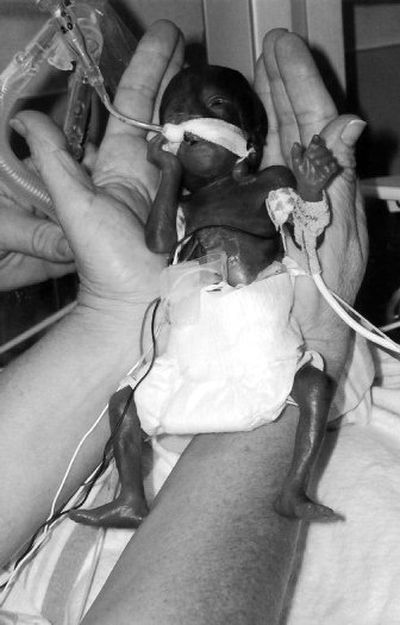Tiny baby gestated less than 22 weeks

MIAMI – A girl born after just under 22 weeks in the womb – among the shortest gestation periods known for a live birth – will remain in a hospital a few extra days as a precaution, officials said Tuesday.
Amillia Sonja Taylor, born Oct. 24, had been expected to be sent home from Baptist Children’s Hospital on Tuesday.
However, routine tests indicated she was vulnerable to infection, said Dr. Paul Fassbach, who has cared for the baby since shortly after she was born.
“She has been fine,” Fassbach said, but doctors are being extra cautious “now that she’s going into the world.”
Doctors say Amillia is among the few babies known to have survived after a gestation of fewer than 22 weeks. She was just 9 1/2 inches long and weighed less than 10 ounces when she was delivered by Caesarean section. Full-term births come after 37 to 40 weeks.
Amillia, the first child for Eddie and Sonja Taylor, of Homestead, now weighs 4 1/2 pounds and is just over 15 1/2 inches long.
Amillia was conceived in vitro and has been in an incubator since birth. She will continue to receive a small amount of supplemental oxygen after she goes home.
She was delivered because her mother was suffering from complications. Fassbach said that if doctors had known Amillia’s real gestational age, they might not have intervened. He said he thought she was at least 23 weeks, and doctors were shocked when the Taylors’ fertility specialist pinpointed the exact date of fertilization.
Fassbach cautioned against rushing to redefine the medical standards for fetus viability.
“We just don’t know which 21- to 22-weekers are going to do well and which are not going to do well,” he said. “I don’t think we should change what we do, but it shows us we need to do more research and find out where our edge of viability is going to go.”
Preterm births occur in about 12 percent of all pregnancies in the U.S., according to the National Institutes of Health.